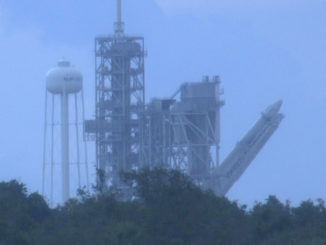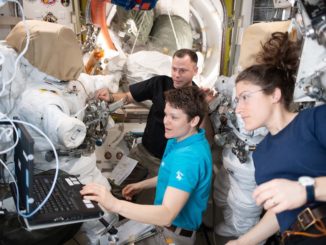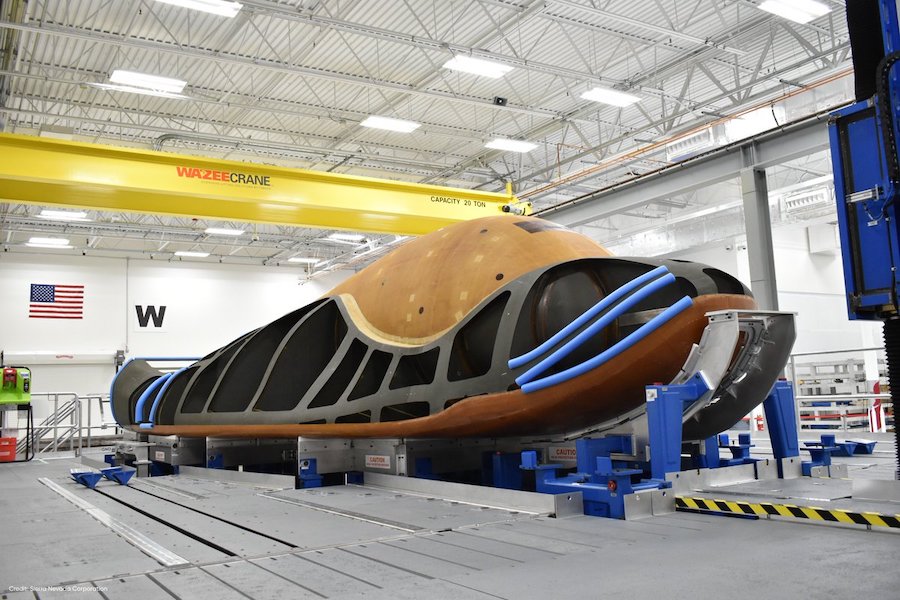
The composite structure of Sierra Nevada Corp.’s first space-rated Dream Chaser space plane has arrived at the company’s Colorado factory for integration with computers, a heat shield and mechanical systems before launch to the International Space Station in late 2021.
The spaceship has been more than 15 years in the making for Sierra Nevada — also known as SNC — a family-owned, privately-held company based in Nevada with a space unit headquartered in Louisville, Colorado, near Denver.
Originally conceived as a human-rated vehicle to ferry astronauts to and from low Earth orbit, the Dream Chaser is now under development under contract to NASA as a cargo freighter for the space station.
Sierra Nevada is contracted to fly at least six resupply missions to the station from 2021 through 2024. NASA’s Commercial Resupply Services-2, or CRS-2, contract added Sierra Nevada to the agency’s fleet of space station cargo vehicles, joining SpaceX’s Dragon and Northrop Grumman’s Cygnus freighters.
The Dream Chaser will take off on top United Launch Alliance Vulcan Centaur rockets from Cape Canaveral, link up with the space station, then return to the Shuttle Landing Facility runway at NASA’s Kennedy Space Center.
The composite pressure shell of the first Dream Chaser designed for spaceflight arrived at Sierra Nevada’s Louisville facility earlier this month from Lockheed Martin’s aircraft factory in Fort Worth, Texas.
The hardware delivered to Sierra Nevada by Lockheed Martin is “arguably one of the most complex and exquisite composite structures that’s ever been built for aerospace applications,” said John Roth, vice president of business development for Sierra Nevada’s space systems division.
Sierra Nevada hosted a ceremony Tuesday to celebrate the structure’s completion and shipment to Colorado.
“This kicks off assembly, integration and test for the vehicle,” said Steve Lindsey, senior vice president of strategy for Sierra Nevada’s space systems business area. “We’ve been through the design. The design is complete. We’re going into the build process now, and shooting for flying in the later part of 2021.”
“We’ve been waiting for this moment foor a long time,” Lindsey said. “This is a really, really complex structure. It’s all composite, no metal fasteners on it at all. It was all baked in an autoclave.”
Lockheed Martin manufactured the Dream Chaser’s composite structure at the same facility in Fort Worth where the company builds F-35 fighter jets.
NASA and Sierra Nevada officials on Tuesday emphasized new capabilities the Dream Chaser will bring to the space station program, including the quick handover of experiment specimens to scientists after return from orbit, which has not been possible since the retirement of the space shuttle.
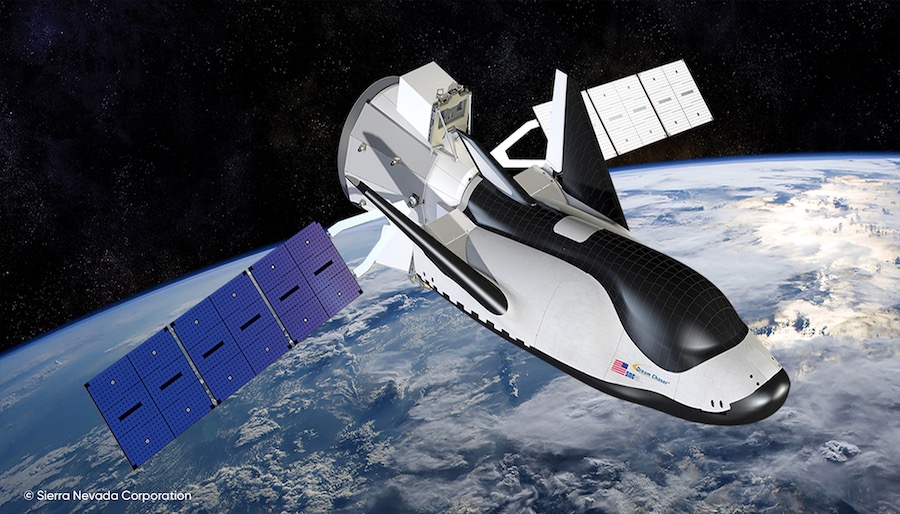
“This vehicle really offers unique capabilities. The ability to fly 5,500 kilos (12,100 pounds) to orbit, it will be our largest cargo vehicle going up to the International Space Station,” said Kirk Shireman, NASA’s space station program manager. “So that capability is really important. Landing safely and softly on a runway really, really close to our facilities, really, really important.”
Research specimens returning to Earth from the space station currently fly on SpaceX’s Dragon cargo vehicles, which splash down at sea, or on Russian Soyuz crew capsules.
Time-critical samples, such as blood and other biological specimens, landed on a Soyuz spacecraft returning from the space station earlier this month.
“We need that back in scientists’ hands in 48 hours,” Shireman said. “You think, well, that’s not so hard. It turns out that we didn’t make 48 hours.
“The Soyuz has to land, we pick them up, fly them in helicopters to an airport that’s three hours away,” Shireman said. “We put them in a jet, fly them in a jet from Kazakhstan all the way to the United States, and somewhere along that line, the aircraft had a problem, and there it sat.”
The Dream Chaser’s ability to land at the Kennedy Space Center, home to life sciences laboratories where the experiment specimens will be analyzed, will avoid the logistical challenges with landings at sea or on the remote steppe of Kazakhstan, halfway around the world.
“With Dream Chaser, the vehicle comes and it lands literally two or three miles from where the scientists are going to be,” Shireman said. “So all that goes away. You have the samples right there. 48 hours now becomes four hours. It really is an amazing capability that we’re looking forward to having.”
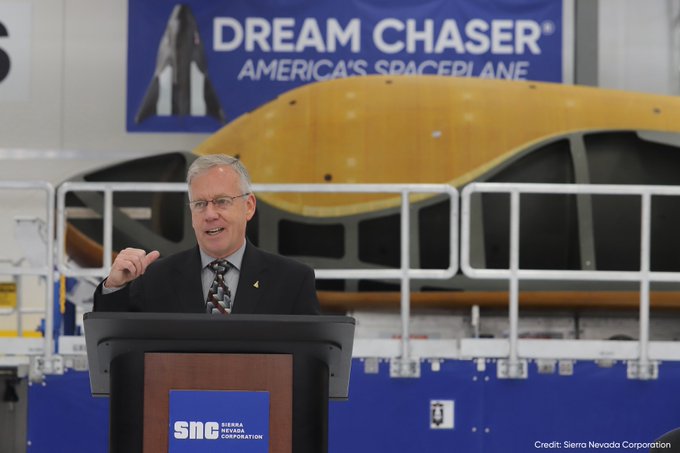
The Dream Chaser will fold its wings to fit inside the payload shroud of its Vulcan Centaur launch vehicle. A disposable pressurized cargo module will launch in tandem with the Dream Chaser, allowing each mission to deliver more than 12,000 pounds to the space station.
At the end of each mission, the Dream Chaser will jettison the cargo module to burn up in the atmosphere with up to 7,400 pounds (3,400 kilometers) of trash and other equipment tagged for disposal.
The Dream Chaser, with its own pressurized compartment, will re-enter the atmosphere and return up to 4,000 pounds (about 1,850 kilograms) of cargo to the ground, including research samples and hardware requiring refurbishment and repairs.
Once the space plane is back on the ground, ground teams will be able to immediately approach the vehicle on the runway to begin offloading cargo. The Dream Chaser propulsion system uses non-toxic propellants, assuaging safety concerns concerns related to potential hazardous fuel leaks after landing.
“As soon as we land, you can get to the vehicle and get to the science,” said John Curry, Sierra Nevada’s CRS-2 program director.
The composite structure built for the Dream Chaser has several benefits, according to Sierra Nevada.
It weighs less than metal allows, it’s easier to manufacture, and it’s resilient to hotter temperatures on re-entry, meaning the spacecraft will be able to carry a lighter heat shield, the company said.
The structure delivered to Sierra Nevada this month weighs about 2,200 pounds, or a metric ton. With the rest of the Dream Chaser’s systems installed, the vehicle’s weight will grow by about a factor of 10.
Over the next year-and-a-half, Sierra Nevada will install wings on the Dream Chaser pressure shell, install computers, add the heat shield and landing gear, and complete the outfitting of the spacecraft for a launch targeted for September 2021.
Sierra Nevada aims complete assembly of the reusable spacecraft in April 2021. The company will next transport the Dream Chaser to NASA’s Plum Brook Station test facility in Ohio to verify its performance in the super-cold, vacuum conditions of space, then the spacecraft will ship to the Kennedy Space Center for final pre-launch processing inside the Operations and Checkout Building.
Curry said Sierra Nevada plans no more approach and landing tests using a Dream Chaser test article that successfully completed a glide test to a runway at Edwards Air Force Base in California in 2017.
Engineers will conduct Dream Chaser ground taxi tests at the Kennedy Space Center runway, according to Sierra Nevada.
Teams will also use a Beechcraft King Air airplane to check out Dream Chaser’s radar altimeters and guidance system on an approach to the Shuttle Landing facility, mimicking the trajectory the space plane will follow on a real mission.
Sierra Nevada says it plans to build a second Dream Chaser vehicle qualified for space missions. Beyond that, the construction of additional Dream Chasers will hinge on market demand.
Each Dream Chaser is designed for at least 15 missions.
Lindsey said Sierra Nevada has “invested heavily” in the Dream Chaser through a cost-sharing public-private partnership with NASA.
“We investing over $1 billion of our own money into this program,” Lindsey said.
Sierra Nevada competed for a contract to develop the Dream Chaser as a crew transport craft, but NASA selected Boeing and SpaceX for the job in 2014.
The ambition to fly astronauts on the Dream Chaser is still alive at Sierra Nevada.
“I do think this is a great people-mover,” Curry said. “It’s like ‘Field of Dreams,’ build it and they will come, and I think we’ll be flying crew soon enough.”
Email the author.
Follow Stephen Clark on Twitter: @StephenClark1.

